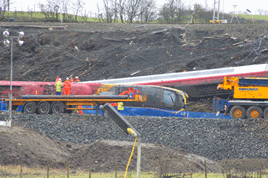Some have questioned the length of time it takes from an incident happening to the publication of the investigation report (it can be several months, or even longer at times). The Branch says it is very conscious of this, and takes criticism of the length of time taken very seriously. So why can it take so long?
The RAIB says the most important elements of the work are being thorough and being right. In respect of being thorough, it aims to add value and improve on what it sees coming from the industry’s own reports.
Industry’s understanding of the techniques of investigation has improved significantly in recent years, but there is still a tendency for investigations to stop at a point where an immediate cause has been found, and not go ‘the extra mile’ to really question why things happened. This is where RAIB’s investigations differ: it keeps asking ‘why?’ until it gets to a point where everyone agrees that there are no more useful answers to find.
As for being right, the RAIB is adamant that its reports must be without error - what gets published has to be as accurate as it possibly can be.
The first stage of an investigation is the site work. This is when the most valuable evidence is usually gathered. As well as making sure that everything of relevance is captured, the RAIB team will also be trying to ensure that the site of the incident is handed back to the rail industry as quickly as possible, so that trains can start running again. Often, this can be before inspectors even get to the site, if it is clear from phone conversations that there is no reason for all or part of the scene to be ‘frozen’ any longer.
For example, in the case of a train striking a pedestrian or cyclist at a level crossing, the train involved can be examined once it has been taken to a depot, and the level crossing can be photographed and surveyed without impeding the passage of trains. What might be crucial in this situation is recording exactly where the train stopped, and it’s often possible to arrange for that information to be recorded by people on site, before the train is moved.
Once the site team has returned to base, the first decision to be made is what (if any) level of investigation is required. This discussion takes place in a meeting of all the inspectors (usually on the Monday following the site work). The inspectors who went to the site present their findings - the course of events, the results of any interviews, reconstructions or tests already carried out, a review of previous relevant investigations (which may go back long before the founding of the RAIB), and a recommendation on what to do next.
Aside from more traditional investigation methods, RAIB staff also keep a close eye on social media. What is said on forums, message boards, Facebook and Twitter may all find its way into the mix when it comes to deciding what action to take.
There have been more than 450 incidents on the railway over the past decade. Thankfully serious railway accidents are rare in the UK, but how is it decided which incidents the RAIB should investigate?
In the Regulations under which RAIB operates (see panel, page 60), there is a definition of ‘serious accident’. If an event falls into this category, it must be investigated. The rest of the investigations undertaken by the RAIB are at its own discretion, based on the decision taken at the Monday meeting. The main criterion is the amount of safety learning that is likely to come out of the investigation.













Comment as guest
Comments
No comments have been made yet.